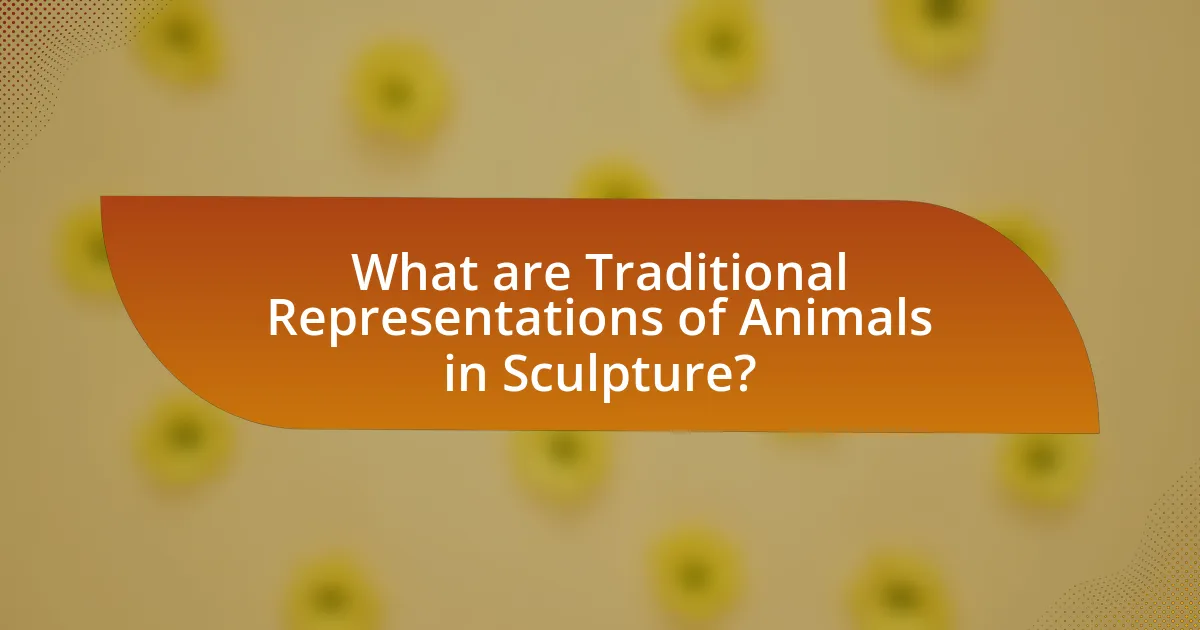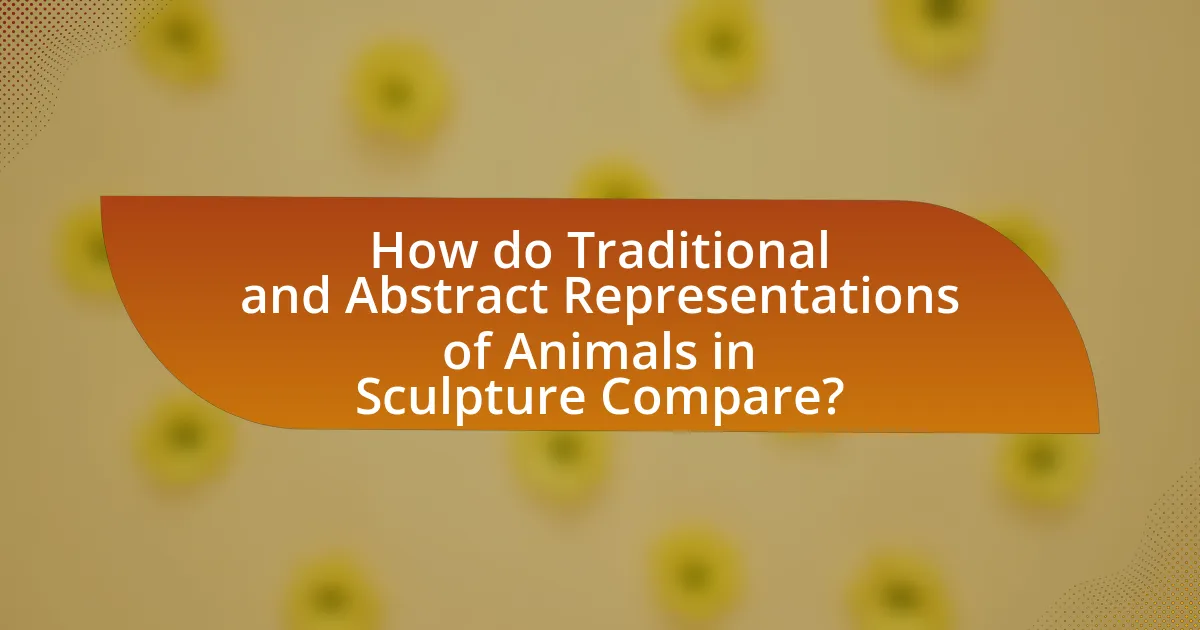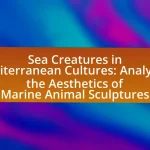The article examines the differences and similarities between traditional and abstract representations of animals in sculpture. It defines traditional sculptures as realistic and detailed, often reflecting cultural significance and historical context, while abstract sculptures prioritize form, color, and emotional expression over realism. Key topics include the materials used in both styles, the influence of cultural context, and the evolution of animal sculptures throughout history. The article also explores how these artistic approaches engage viewers and convey themes of nature and existence, highlighting the practical considerations artists should keep in mind when choosing between the two styles.

What are Traditional Representations of Animals in Sculpture?
Traditional representations of animals in sculpture are realistic and detailed depictions that aim to capture the physical characteristics and behaviors of the animals. These sculptures often reflect cultural significance, serving as symbols of power, spirituality, or nature in various societies. For example, ancient Egyptian sculptures of cats and falcons were not only artistic expressions but also held religious meanings, representing deities and protection. Similarly, Greek sculptures of horses and lions showcased idealized forms, emphasizing strength and beauty, which were central to their cultural values. This focus on realism and cultural context validates the importance of traditional animal representations in sculpture throughout history.
How do Traditional Sculptures depict animals?
Traditional sculptures depict animals through realistic representations that emphasize anatomical accuracy and naturalistic features. Artists often focus on the physical characteristics, behaviors, and habitats of the animals, aiming to capture their essence and vitality. For instance, ancient Greek sculptures, such as those from the Parthenon, showcase horses and other animals with detailed musculature and lifelike poses, reflecting a deep understanding of their anatomy. Similarly, traditional African sculptures often incorporate symbolic elements while maintaining recognizable forms, illustrating cultural significance alongside realism. This approach contrasts with abstract representations, which may prioritize stylization over realism.
What materials are commonly used in Traditional Animal Sculptures?
Traditional animal sculptures commonly utilize materials such as wood, stone, clay, and metal. Wood has been a favored medium due to its availability and workability, allowing artisans to create intricate designs. Stone, including marble and granite, is often used for its durability and the ability to achieve fine detail, as seen in classical sculptures. Clay serves as a versatile material for modeling and firing, enabling the creation of both small and large-scale works. Metal, particularly bronze, is valued for its strength and the ability to capture fine details through casting techniques. These materials have been historically significant in various cultures, reflecting the artistic traditions and available resources of the time.
How does cultural context influence Traditional Animal Sculptures?
Cultural context significantly influences traditional animal sculptures by shaping the themes, materials, and techniques used in their creation. For instance, in many Indigenous cultures, animal sculptures often reflect spiritual beliefs and the relationship between humans and nature, as seen in the totem poles of Native American tribes, which symbolize ancestral lineage and cultural stories. Additionally, the choice of materials, such as wood, stone, or clay, is often dictated by the resources available in a specific region, which further ties the sculptures to the cultural identity of the community. Historical practices, such as the use of animal motifs in ancient Egyptian art to convey power and divinity, demonstrate how cultural narratives and societal values are embedded in these artworks. Thus, traditional animal sculptures serve as a visual representation of the cultural context from which they originate, encapsulating the beliefs, resources, and artistic practices of a society.
What are the historical origins of Traditional Animal Sculptures?
Traditional animal sculptures have their historical origins in prehistoric art, particularly evident in cave paintings and carvings from the Upper Paleolithic period, around 40,000 years ago. These early representations, found in locations such as Lascaux in France and Altamira in Spain, indicate that early humans used animal forms to express their relationship with nature and the importance of animals in their survival. Over time, various cultures, including ancient Egyptians, Greeks, and Indigenous peoples, developed their own styles and techniques, often incorporating spiritual or symbolic meanings into their sculptures. For instance, ancient Egyptians created detailed animal sculptures to honor deities, while the Greeks emphasized realism and anatomical accuracy in their works, reflecting their understanding of the natural world.
Which civilizations are known for their Traditional Animal Sculptures?
Civilizations known for their traditional animal sculptures include the ancient Egyptians, the Greeks, and the indigenous cultures of Africa and the Americas. The ancient Egyptians created intricate sculptures of animals such as cats and falcons, often associated with their deities, while the Greeks produced realistic representations of animals in their art, reflecting their appreciation for nature. Indigenous African cultures, such as the Dogon and the Yoruba, crafted animal figures that held spiritual significance, and Native American tribes created totem poles featuring animal carvings that represented clan lineage and beliefs. These civilizations utilized animal sculptures to convey cultural values, religious beliefs, and social structures, demonstrating the importance of animals in their respective societies.
How have Traditional Animal Sculptures evolved over time?
Traditional animal sculptures have evolved significantly from ancient times to the present, reflecting changes in cultural values, artistic techniques, and materials. Initially, these sculptures were primarily functional, serving religious or utilitarian purposes, as seen in ancient Egyptian and Mesopotamian art, where animals symbolized deities or were used in rituals. Over time, during the Classical period, the focus shifted towards realism and anatomical accuracy, exemplified by Greek sculptures that celebrated the beauty of animals in a more naturalistic style.
In the Middle Ages, animal representations became more stylized and symbolic, often reflecting the spiritual beliefs of the time, as seen in Gothic cathedrals where animals were depicted in a more abstract manner. The Renaissance marked a return to realism, with artists like Albrecht Dürer meticulously studying and depicting animals with great detail.
In modern times, traditional animal sculptures have further diversified, incorporating contemporary materials and techniques, while also blending with abstract forms. Artists now explore themes of conservation and the relationship between humans and nature, leading to innovative interpretations that challenge the boundaries of traditional representation. This evolution illustrates a continuous dialogue between cultural significance and artistic expression in the realm of animal sculpture.

What are Abstract Representations of Animals in Sculpture?
Abstract representations of animals in sculpture are artistic interpretations that emphasize form, color, and texture over realistic depictions. These sculptures often distill the essence or symbolic qualities of the animal rather than aiming for anatomical accuracy. For example, works by artists like Henry Moore or Barbara Hepworth utilize simplified shapes and organic forms to convey the spirit of animals, focusing on emotional resonance rather than literal representation. This approach allows for a broader interpretation and connection with the viewer, as abstract forms can evoke feelings and ideas that transcend specific animal characteristics.
How do Abstract Sculptures interpret animals?
Abstract sculptures interpret animals by distilling their essence into simplified forms and shapes, often emphasizing movement, emotion, or symbolic meaning rather than realistic representation. This approach allows artists to convey the spirit or concept of the animal, focusing on attributes such as grace, power, or instinct. For example, the works of artists like Henry Moore and Barbara Hepworth utilize organic shapes and fluid lines to evoke the presence of animals, rather than depicting them in a literal sense. This method encourages viewers to engage with the sculpture on a conceptual level, prompting personal interpretations and emotional responses that transcend traditional portrayals.
What techniques are used in Abstract Animal Sculptures?
Abstract animal sculptures utilize techniques such as simplification, distortion, and the use of non-traditional materials. Simplification involves reducing the form of the animal to its essential shapes, allowing for a more conceptual representation. Distortion may include altering proportions or features to evoke emotion or provoke thought, rather than aiming for realism. Additionally, artists often incorporate non-traditional materials like metal, glass, or found objects, which can enhance the abstract quality and challenge conventional perceptions of animal forms. These techniques collectively enable artists to express ideas and emotions associated with animals beyond their physical characteristics.
How does abstraction affect the viewer’s perception of animals?
Abstraction alters the viewer’s perception of animals by emphasizing certain characteristics while downplaying others, leading to a more subjective interpretation. In abstract representations, the essence or emotional quality of the animal may be highlighted through simplified forms, colors, or textures, which can evoke different feelings or thoughts compared to traditional representations that focus on realistic details. For instance, a sculpture that abstracts an animal’s shape may prompt viewers to consider the animal’s symbolic meaning or emotional resonance rather than its physical attributes. This shift in focus can lead to a broader range of interpretations and emotional responses, as seen in the works of artists like Henry Moore, whose abstract forms invite viewers to engage with the essence of the subject rather than its literal appearance.
What are the philosophical underpinnings of Abstract Animal Sculptures?
Abstract animal sculptures are grounded in philosophical concepts such as existentialism, symbolism, and the exploration of perception. These sculptures often challenge traditional representations by emphasizing the essence of the animal rather than its realistic form, reflecting existentialist ideas about the nature of existence and individuality. For instance, artists like Henry Moore and Barbara Hepworth utilized abstraction to convey deeper emotional and spiritual connections to the animal form, suggesting that the essence of the subject transcends physical appearance. This approach aligns with the philosophical notion that art can evoke a subjective experience, allowing viewers to interpret meaning based on personal perception rather than objective reality. The use of abstraction in animal sculptures invites contemplation on the relationship between humanity and nature, encouraging a dialogue about identity, existence, and the interconnectedness of all living beings.
How do Abstract Sculptures challenge traditional views of representation?
Abstract sculptures challenge traditional views of representation by prioritizing form, color, and texture over realistic depiction. Unlike traditional sculptures that aim to replicate the physical characteristics of subjects, abstract sculptures often distort or simplify these features, encouraging viewers to engage with the artwork on an emotional or conceptual level rather than a literal one. This shift in focus allows for a broader interpretation of meaning, as seen in works by artists like Henry Moore and Barbara Hepworth, who emphasized organic shapes and spatial relationships, thereby redefining the viewer’s experience and understanding of representation in art.
What role does emotion play in Abstract Animal Sculptures?
Emotion plays a crucial role in Abstract Animal Sculptures by conveying feelings and concepts that transcend literal representation. These sculptures often evoke emotional responses through their forms, colors, and textures, allowing viewers to interpret the artist’s intent and connect with the artwork on a personal level. For instance, the use of exaggerated shapes or dynamic lines can suggest movement or energy, prompting feelings of excitement or tranquility. This emotional engagement is supported by studies in art psychology, which indicate that abstract forms can stimulate the imagination and elicit strong emotional reactions, as seen in the works of artists like Henry Moore and Barbara Hepworth, who utilized abstraction to express complex emotional states.

How do Traditional and Abstract Representations of Animals in Sculpture Compare?
Traditional representations of animals in sculpture focus on realistic depictions, emphasizing anatomical accuracy and lifelike details, while abstract representations prioritize form, color, and emotional expression over realism. Traditional sculptures, such as those from ancient Greece, often aim to capture the essence and beauty of the animal, as seen in works like the “Lion of Knidos,” which showcases intricate details and proportions. In contrast, abstract sculptures, like those by modern artists such as Henry Moore, utilize simplified shapes and forms to evoke feelings or concepts associated with animals rather than their physical characteristics. This distinction highlights the differing artistic intentions: traditional art seeks to replicate nature, while abstract art aims to interpret and convey deeper meanings.
What are the key differences between Traditional and Abstract Animal Sculptures?
Traditional animal sculptures focus on realistic representations, capturing the anatomical details and natural poses of animals, often reflecting cultural or historical significance. In contrast, abstract animal sculptures prioritize form, color, and emotion over realism, using stylized shapes and non-representational elements to evoke feelings or concepts rather than depict the animal accurately. For example, traditional sculptures like those from ancient Greece emphasize lifelike features, while modern abstract works may use geometric forms to suggest the essence of an animal without direct representation.
How do the artistic intentions differ between Traditional and Abstract representations?
Traditional representations aim to accurately depict subjects, focusing on realism and detail to convey a recognizable form, often reflecting cultural values and historical context. In contrast, abstract representations prioritize expression and emotional impact over realistic portrayal, using shapes, colors, and forms to evoke feelings or ideas rather than to represent the subject literally. This distinction is evident in the works of artists like Auguste Rodin, who emphasized lifelike detail in traditional sculpture, versus Henry Moore, whose abstract forms challenge viewers to interpret meaning beyond physical representation.
What impact do these differences have on audience engagement?
Differences between traditional and abstract representations of animals in sculpture significantly impact audience engagement by influencing emotional responses and interpretative experiences. Traditional sculptures often evoke familiarity and nostalgia, allowing audiences to connect with recognizable forms and cultural narratives, which can enhance emotional engagement. In contrast, abstract sculptures challenge viewers to interpret meaning and engage their imagination, fostering a more active participation in the viewing experience. Research indicates that artworks that provoke thought and personal interpretation can lead to deeper cognitive engagement, as seen in studies by the Journal of Aesthetic Education, which highlight that abstract art encourages viewers to explore their own perceptions and emotions. Thus, the distinct characteristics of each representation style shape how audiences interact with and respond to the artwork.
What are the similarities between Traditional and Abstract Animal Sculptures?
Traditional and Abstract Animal Sculptures share several similarities, primarily in their thematic focus on animals and their role in expressing cultural or emotional narratives. Both forms utilize materials such as stone, metal, or wood, allowing for a tactile connection to the subject matter. Additionally, both styles often aim to evoke a response from the viewer, whether through realistic representation in traditional sculptures or through emotional abstraction in abstract forms. Furthermore, both types can reflect the artist’s interpretation of the animal, showcasing creativity and individual expression.
How do both styles convey themes of nature and existence?
Both traditional and abstract styles convey themes of nature and existence through their distinct representations of animals. Traditional sculpture often emphasizes realistic forms and details, reflecting the natural world and the interconnectedness of life, which highlights the existence of animals within their ecosystems. In contrast, abstract sculpture distills the essence of animals into simplified shapes and forms, prompting viewers to contemplate the broader themes of existence and the intrinsic qualities of life beyond physical representation. This duality allows both styles to explore the relationship between humanity and nature, illustrating how different artistic approaches can evoke profound reflections on existence.
In what ways do both styles reflect cultural values?
Traditional and abstract styles of animal sculpture reflect cultural values through their differing approaches to representation and symbolism. Traditional sculptures often emphasize realism and detail, showcasing animals in a way that aligns with cultural reverence for nature and the importance of specific species within a community, as seen in ancient Egyptian sculptures that depicted animals as deities. In contrast, abstract sculptures prioritize form and emotion, reflecting modern cultural values of individual expression and the subjective interpretation of nature, as evidenced by contemporary artists who use abstraction to challenge viewers’ perceptions of animals and their roles in society. This divergence illustrates how each style embodies the values and beliefs of its respective culture, whether through adherence to realism or exploration of abstraction.
What practical considerations should artists keep in mind when choosing between Traditional and Abstract styles?
Artists should consider their target audience and the intended message when choosing between Traditional and Abstract styles. Traditional styles often appeal to audiences who appreciate realism and detailed representation, while Abstract styles may attract those who favor emotional expression and conceptual interpretation. Additionally, the choice of materials and techniques can influence the decision; Traditional sculpture typically requires specific skills and tools for realistic depiction, whereas Abstract sculpture may allow for more experimentation with form and texture. Understanding market trends and personal artistic goals also plays a crucial role, as artists may find greater commercial success or personal satisfaction in one style over the other.


